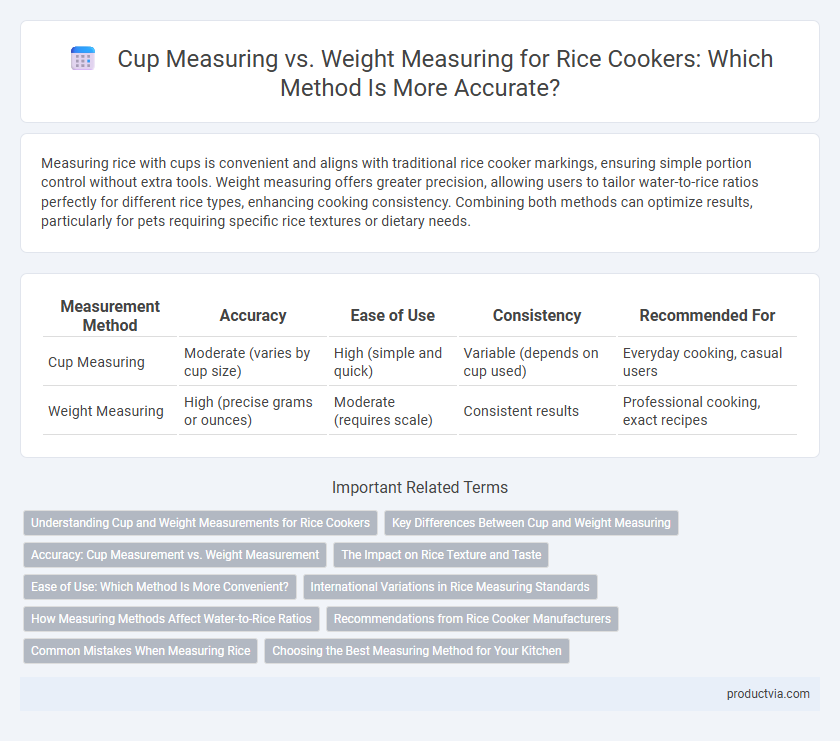Measuring rice with cups is convenient and aligns with traditional rice cooker markings, ensuring simple portion control without extra tools. Weight measuring offers greater precision, allowing users to tailor water-to-rice ratios perfectly for different rice types, enhancing cooking consistency. Combining both methods can optimize results, particularly for pets requiring specific rice textures or dietary needs.
Table of Comparison
| Measurement Method | Accuracy | Ease of Use | Consistency | Recommended For |
|---|---|---|---|---|
| Cup Measuring | Moderate (varies by cup size) | High (simple and quick) | Variable (depends on cup used) | Everyday cooking, casual users |
| Weight Measuring | High (precise grams or ounces) | Moderate (requires scale) | Consistent results | Professional cooking, exact recipes |
Understanding Cup and Weight Measurements for Rice Cookers
Rice cookers often rely on cup measurements specific to their design, where one cup typically equals 180 milliliters, differing from standard kitchen cups. Weight measurements, usually in grams, provide precise control over rice quantity, essential for consistency in texture and cooking results. Understanding the variance between volume and weight measurements helps optimize rice-to-water ratios, ensuring perfectly cooked rice every time.
Key Differences Between Cup and Weight Measuring
Cup measuring in rice cookers relies on volume measurement, using standardized plastic or glass rice cups, typically holding about 180 ml, which simplifies portioning but can vary by rice type and moisture content. Weight measuring uses a precise kitchen scale to provide exact grams or ounces, ensuring consistent results and better control over water-to-rice ratios for different rice varieties. The key difference lies in accuracy: cup measuring is convenient for everyday use, while weight measuring offers superior precision critical for recipes demanding exact measurements.
Accuracy: Cup Measurement vs. Weight Measurement
Weight measurement offers superior accuracy for rice cookers compared to cup measuring, ensuring precise water-to-rice ratios tailored to rice type and desired texture. Cup measurements can vary significantly depending on cup size and rice grain density, leading to inconsistent cooking results. Using a digital scale minimizes guesswork and enhances cooking precision, delivering perfectly cooked rice every time.
The Impact on Rice Texture and Taste
Using cup measuring in rice cookers often leads to inconsistent rice texture and taste due to variations in cup sizes and rice grain density. Weight measuring ensures precise rice-to-water ratios, resulting in perfectly cooked rice with ideal moisture and tenderness. Accurate measurements directly influence the rice's fluffiness and flavor, enhancing the overall eating experience.
Ease of Use: Which Method Is More Convenient?
Measuring rice by cup is more convenient for everyday use with rice cookers because it eliminates the need for a kitchen scale and simplifies portion control, aligning directly with the cooker's built-in cup measurements. Weight measuring offers greater precision for recipes requiring exact ratios, but it can slow down the cooking process due to additional equipment and steps. Most rice cookers are designed to function optimally with cup measurements, enhancing ease of use for consistent results.
International Variations in Rice Measuring Standards
Rice cookers worldwide often use cup measuring units that vary from the standard 240 ml cup, with Japanese rice cookers typically using a 180 ml cup and Korean cookers adopting a 210 ml cup, causing discrepancies in rice-to-water ratios. Weight measuring offers a more precise method, accommodating regional rice varieties and moisture content variations that cup measurements cannot capture. Understanding these international differences is crucial for achieving optimal cooking results and consistency in texture across diverse rice cooker models.
How Measuring Methods Affect Water-to-Rice Ratios
Measuring methods directly impact the water-to-rice ratio in rice cookers, where cup measuring uses volume-based units, often leading to slight variations in rice density and thus water requirements. Weight measuring provides a precise and consistent rice quantity, enabling accurate water calibration based on the specific rice type, improving cooking consistency. Accurate water-to-rice ratios are crucial for optimal texture, as variations in measurement can cause undercooked or overcooked rice.
Recommendations from Rice Cooker Manufacturers
Rice cooker manufacturers typically recommend using the specific measuring cup that comes with the appliance because it is calibrated to the cooker's water-to-rice ratio, ensuring optimal texture and cooking results. Weight measuring, while more precise, may not align perfectly with the manufacturer's instructions and can lead to inconsistent outcomes if water levels are not adjusted accordingly. Following the provided cup measurements simplifies the cooking process and maintains the intended performance of the rice cooker.
Common Mistakes When Measuring Rice
Common mistakes when measuring rice for rice cookers include relying solely on cup measurements without accounting for rice type or moisture content, which can lead to inconsistent cooking results. Using weight measurements, typically in grams, provides more accuracy by standardizing the amount regardless of grain size or density. Inaccurate measurements often cause undercooked or overcooked rice, affecting texture and flavor.
Choosing the Best Measuring Method for Your Kitchen
Choosing the best measuring method for your kitchen depends on accuracy and convenience tailored to rice cookers. Weight measuring offers precision using grams or ounces, ensuring consistent rice texture and portion control. Cup measuring provides ease and speed, using standardized rice cups designed for specific cooker models, ideal for everyday cooking without needing scales.
Cup measuring vs weight measuring for rice cookers Infographic

 productvia.com
productvia.com